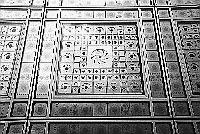Judging by the workmanship and the dating (1927 - Arabic numerals, but western calendar), I'm going to say that it's probably Turkish.
I don't read Arabic. I wonder what the inscription says. Pablo didn't see any reference to Allah. Could it be a poem about a flame? About lighting up a night? I guess I could attempt to transliterate the calligraphy and hopefully be able to, based on that, look it up in a dictionary. What a fun little puzzle.
My musings on this led me to review the Omniglot site. They've done a fair bit of revamping there - go take a look at it. It's ten times more excellent than it was before in its older, pretty darned neato state.
From that, I found links to Berber World. Here, I found a wonderful collection of news on the indigenous North African world - the Tamazights, the Rafs, the Berbers, the Tuaregs. How interesting to see that Tamazight is being taught again in schools in Morocco!
From the monde des berberes, I moved to a different perspective - a French one, but revisiting one of my favorite museums in Paris. This was my first contact with the art and history of the 'Arab' world - from the Palmyrans to the Moors and right on up to modern day Maghrebin culture. My, how I'd love getting back to see what's new there.

Now, I'm thinking of Tahar ben Jalloun. How is it that there seem to be very few if any English translations left of his novels? This needs to be remedied.


No comments:
Post a Comment